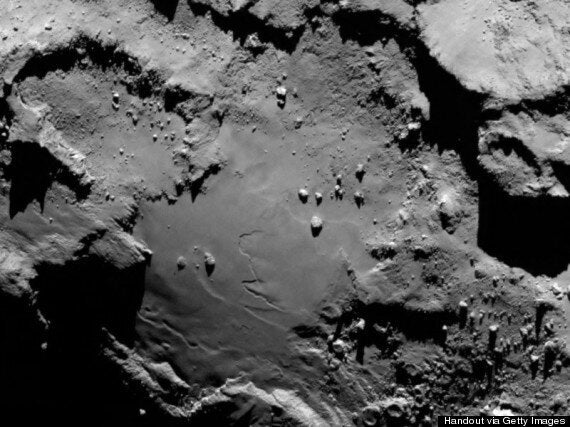Humanity has landed on a comet for the first time.
After a ten year, billion-euro mission that took the Rosetta space craft on a journey of more than 6.4 billion kilometers, the European Space Agency successfully landed on Comet 67P - a 2.5 mile-wide lump of ice and dust hurtling through space at around 40,000mph.
The ESA team is still evaluating how the Philae lander is operating after the 14-mile descent, but they are hopeful that the mission went as planned.
UPDATE 6:
Jean Jacques Dordain, ESA director general, said:
"Philae has landed… This is a big step for human civilisation. This is science, scientsts, knowledge, and… that makes a difference.
I would like at this stage to repeat what I say after each success. The biggest problem is that it looks easy… When you know the sum of expertise, dedication, the sum of teamwork between 20 nationalities of member states of Europe… when you know that. You know that this type of success is not coming from the sky. It comes from hard work."
UPDATE 5:
It appears the lander has made it to the comet safely.
UPDATE 4:
ESA has announced for the first time that when the Rosetta mothership runs out of fuel in 2016, it may attempt to land it on the comet too - meaning that it will be reunited with Philae and stay on its surface for as long as the comet exists (or until it is flung off).
UPDATE 3:
Now we have an image of the Philae rover falling away from Rosetta
UPDATE 2:
ESA unveils first image of Rosetta taken from Philae.
UPDATE:
Philae lander successfully detaches from Rosetta.
#COMETLANDING: Full Coverage
ESA controllers held their breath in the early hours of 12 November, hoping that the spider-like probe could reach the surface of comet 67P/Churyumov-Gerasimenko safely.
Touchdown took place at 4:05pm UK time.
Nine years ago the US space agency Nasa's Deep Impact mission smashed a projectile into comet Tempel 1 to study debris from the blast. Philae, in contrast, floated gently down at walking pace.
During the descent it was be beyond the control of scientists on Earth, relying on automated systems and careful pre-programming.
As the dishwasher-sized robot made contact with the surface it pins itself down with two harpoons and ice screws attached to each of its three legs. Without these anchors there would have been a risk of the probe bouncing away into space in the extremely low gravity.
Here is a rough timeline of how it will unfold:
- Midnight - second "go/no go" call to confirm the separation of Rosetta and Philae
- 1.35 am - third "go/no go"
- 9 am - Philae separates from Rosetta to start its descent
- 9.33 am - ESA receives confirmation that the separation has occurred
- 11.23 am - Philae sends its first signal directly to Earth
- 4.04 pm - Philae lands on 67P
- 4.34 pm - Earth finds out if all the above took place
#COMETLANDING: Full Coverage
Speaking earlier Rosetta flight director Andrea Accomazzo said: "We have to be a bit lucky. If the lander lands in the proximity of a boulder there is nothing we can do."
The chosen landing site, named Agilka after an island in the Nile, was the least hazardous of five possible candidates. But the whole of the comet is covered in deep pits, towering cliffs and peaks, craters and boulders - some the size of houses.
Philae has landed on the smaller of two lobes that make up the comet, giving it the appearance of a "rubber duck".
The robot is equipped with cameras, a suite of 10 instruments, and a drill that can bore out samples to a depth of 23cm.
One British-led instrument, Ptolemy, will be used to analyse the composition of samples in the craft's on-board laboratory.
Philae is designed to collect data on the surface of the comet for just two and a half days, but the Rosetta orbiter will remain with the comet as it flies past the Sun and heats up, approaching as close as 118 million miles.
The landing is the culmination of a mission that began with the launch of Rosetta 10 years ago. The spacecraft finally caught up with the fast-moving comet in August after an epic four billion-mile journey that took it across the asteroid belt.
Information from the mission is expected to shed new light on the origin of the Solar System, the Earth and possibly even life.

Planetary scientist Professor Stanley Cowley, from the University of Leicester, who worked on the planning stages of Rosetta, said: "Comet impacts are thought to have been one of the principal means by which water was delivered to the early Earth around 3.6 billion years ago, possibly contributing half the water in our oceans.
"Furthermore, the comet material is also known to contain simple organic molecules which may also have seeded Earth with the material from which life emerged."
British astronomer Dr Daniel Brown, from Nottingham Trent University, said:
"Although we have landed on planets, moons and asteroids, it has never been attempted for a nucleus of a comet - and with good reason. These objects have a very low gravity, are loosely composed of ice, dust and rocks, and are very irregular in shape. They are temperamental in their behaviour and notoriously difficult to predict.
"Apart from the amazing scientific results, the sheer challenge and ambition of such a mission is outstanding and illustrates how our space exploration of the Solar System has become more advanced and successful. It gives us much to hope for in future missions."